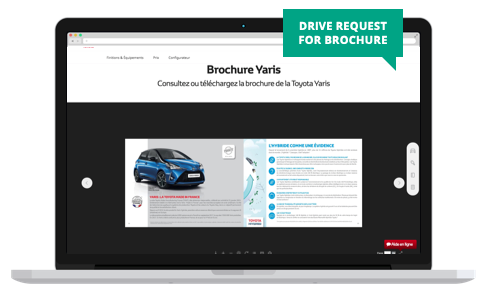
How car brands can identify future buyers online using AI
With consumers still preferring to buy cars from dealers, are the websites of automotive brands only useful as research tools? The answer is of course, far from it!
1 What are the conversion goals for automotive websites?
To begin, let’s define what conversion means for a car maker’s website, as clearly, unlike retail e-commerce sites, it isn’t about putting a vehicle in your shopping cart and hitting the Buy button!
Instead, car manufacturers' websites have several objectives:
- Engage prospects with the brand, by serving as a showcase and brochure
- Communicate current offers at a lower cost than other advertising channels. There’s a big cost difference between running a promotion on your homepage compared to a TV or radio advertising slot
- Generate test drive requests that can be passed to dealers. This is a crucial step in the purchasing process and acts as a real bridge between the digital and physical worlds
Converting on an automotive site means achieving one of these business objectives.
How can manufacturers best harness the marketing and commercial potential of their site to achieve all of these conversion objectives? In my opinion, the answer means focusing on a key principle: the principle of balance.
2 The balance between the brand’s level of action and the maturity of the visitor in their purchasing journey
Offer brochures to a visitor who is 99% convinced which model they want to buy and this risks delaying them in their decision-making, confusing their experience, and potentially stopping them moving forward to purchase.
In the same way, bombarding a casual visitor with detailed promotional communications risks overwhelming them and thus losing a future sales opportunity.
Finally, offering a test drive to prospects too early in the sales cycle can generate additional costs because of the low probability that they will actually buy from you.
The key to success is therefore to be able to accurately measure the purchase intent of each site visitor in order to offer them a personalized action that exactly matches their position in the buying cycle.
With Kameleoon, it's possible!
Our AI personalization technology allows you to identify the maturity of every visitor, even if they remain anonymous, and to segment them so that they are targeted with the right messages and actions at the right time. This enables car manufacturers to get as close as possible to achieving the balance I’ve described above.
What is AI personalization?
Kameleoon’s AI personalization technology allows digital messages, offers and content to be adapted in real-time, based on the conversion probability of each visitor at that moment in time.
This technology is based on machine learning algorithms, which analyze all the data generated by visitors to a site, and make predictions about the behavior of each visitor, whether identified or anonymous, customer or first-time visitor.
This is illustrated by a heat score, the Kameleoon Conversion Score (KCS), which translates the probability of conversion into a concrete metric for marketers.

Depending on the visitor's conversion score, personalized actions are triggered on the site. For example, the website graphics and content could be changed, targeted offers generated or messages personalized based on criteria set by the brand.
3 3 applications of AI personalization for the automotive sector
Target visitors who are still in the exploratory phase
Even if the sales funnel of a car manufacturer site ends once a request for a test drive at a dealership is made, there are a multitude of preliminary steps before then.
It is important to support visitors throughout their own purchase journey. AI personalization allows you to identify which phase of their journey each visitor is in and to trigger appropriate actions based on their progress through the funnel.
To help with this, the AI personalization algorithm can determine the probability of the visitor in converting and asking for a test drive. In other words, it predicts the odds of a visitor achieving the site’s ultimate objective.
If these chances are low, you can see that the visitor is still researching their options. The brand can target these visitors who are still “cold” with the option of receiving a personalized brochure via email or download from the site.
This both provides relevant support to the consumer, and gathers contact information that will allow the brand to continue to nurture the relationship with this now identifiable visitor.

Target visitors who are in an indecisive phase
Other visitors may find themselves in an intermediate situation: not ready for a test drive, but still showing interest in the models shown on the website.
AI personalization algorithms make it possible to identify who belongs to this category of undecided visitors, and to alert them to current promotions that may move their decision making forward.
It is possible to go further by identifying amongst “hot” visitors those who need information around specific points, such as the different options available or an estimate of the final price, before making their decision. You can then push these visitors to a personalized vehicle configuration page that lets them create their and compare different options.
This will sometimes provide the boost necessary to push them to make a test drive request, or even move to final purchase.
Target visitors who are ready to try a vehicle at the dealership
The third and last type of visitor are those in the ‘hot’ category, who have a high probability of making a test drive request.
Again, the AI personalization algorithm identifies who, amongst site visitors, is at this stage of the purchase, and offers them a simplified, personalized offer of a test drive via a pop-in.

Adopting an AI-based personalization strategy therefore allows automotive sites to identify future buyers online, in order to offer them the best, tailored support, nurturing them until they are ready to visit a dealership for a test-drive.


